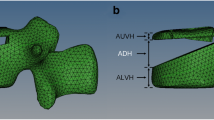Abstract
Purpose
Posterior reduction and pedicle screw fixation is a widely used procedure for thoracic and lumbar vertebrae fractures. Usually, the pedicle screws would be removed after the fracture healing and screw tunnels would be left. The aim of this study is to evaluate the effect of screw tunnels on the biomechanical stability of the lumbar vertebral body after pedicle screws removal by finite element analysis (FEA).
Methods
First, the CT values of the screw tunnels wall in the fractured vertebral bodies were measured in patients whose pedicle screws were removed, and they were then compared with the values of vertebral cortical bone. Second, an adult patient was included and the CT images of the lumbar spine were harvested. Three dimensional finite element models of the L1 vertebra with unilateral or bilateral screw tunnels were created based on the CT images. Different compressive loads were vertically acted on the models. The maximum loads which the models sustained and the distribution of the force in the different parts of the models were recorded and compared with each other.
Results
The CT values of the tunnels wall and vertebral cortical bone were 387.126±62.342 and 399.204±53.612, which were not statistically different (P=0.149). The models of three dimensional tetrahedral mesh finite element of normal lumbar 1 vertebra were established with good geometric similarity and realistic appearance. After given the compressive loads, the cortical bone was the first one to reach its ultimate stress. The maximum loads which the bilateral screw tunnels model, unilateral screw tunnel model, and normal vertebral model can sustain were 3.97 Mpa, 3.83 Mpa, and 3.78 Mpa, respectively. For the diameter of the screw tunnels, the model with a diameter of 6.5 mm could sustain the largest load. In addition, the stress distributing on the outside of the cortical bone gradually decreased as the thickness of the tunnel wall increased.
Conclusions
Based on the FEA, pedicle screw tunnels would not decrease the biomechanical stability and strength of the vertebral body. A large diameter of screw tunnel and thick tunnel wall were helpful for the biomechanical stability of the vertebral body.


Similar content being viewed by others
References
Roy-Camille R, Saillant G, Mazel C (1986) Internal fixation of the lumbar spine with pedicle screw plating. Clin Orthop Relat Res 203:7–17
Jeon CH, Lee HD, Lee YS, Seo JH, Chung NS (2015) Is it beneficial to remove the pedicle screw instrument after successful posterior fusion of thoracolumbar burst fractures? Spine 40(11):E627–E633
Geng JP, Tan KB, Liu GR (2001) Application of finite element analysis in implant dentistry: a review of the literature. J Prosthet Dent 85(6):585–598
Papini M, Zdero R, Schemitsch EH, Zalzal P (2007) The biomechanics of human femurs in axial and torsional loading: comparison of finite element analysis, human cadaveric femurs, and synthetic femurs. J Biomech Eng 129(1):12–19
Magerl F, Aebi M, Gertzbein SD, Harms J, Nazarian S (1994) A comprehensive classification of thoracic and lumbar injuries. Eur Spine J 3(4):184–201
Zhang QH, Teo EC (2008) Finite element application in implant research for treatment of lumbar degenerative disc disease. Med Eng Phys 30(10):1246–1256
Chen CS, Chen WJ, Cheng CK, Jao SH, Chueh SC, Wang CC (2005) Failure analysis of broken pedicle screws on spinal instrumentation. Med Eng Phys 27(6):487–496
Ayberk G, Ozveren MF, Altundal N, Tosun H, Seckin Z, Kilicarslan K, Kaplan M (2008) Three column stabilization through posterior approach alone: transpedicular placement of distractable cage with transpedicular screw fixation. Neurol Med Chir (Tokyo) 48(1):8–14
Du CF, Yang N, Guo JC, Huang YP, Zhang C (2016) Biomechanical response of lumbar facet joints under follower preload: a finite element study. BMC Musculoskelet Disord 17:126
Tsouknidas A, Sarigiannidis SO, Anagnostidis K, Michailidis N, Ahuja S (2015) Assessment of stress patterns on a spinal motion segment in healthy versus osteoporotic bony models with or without disc degeneration: a finite element analysis. Spine J 15(3 Suppl):S17–S22
Choi KC, Ryu KS, Lee SH, Kim YH, Lee SJ, Park CK (2013) Biomechanical comparison of anterior lumbar interbody fusion: stand-alone interbody cage versus interbody cage with pedicle screw fixation -- a finite element analysis. BMC Musculoskelet Disord 14:220
Zanjani-Pour S, Winlove CP, Smith CW, Meakin JR (2016) Image driven subject-specific finite element models of spinal biomechanics. J Biomech 49(6):919–925
Turkyilmaz I, Tumer C, Ozbek EN, Tözüm TF (2007) Relations between the bone density values from computerized tomography, and implant stability parameters: a clinical study of 230 regular platform implants. J Clin Periodontol 34(8):716–722
Kopperdahl DL, Morgan EF, Keaveny TM (2002) Quantitative computed tomography estimates of the mechanical properties of human vertebral trabecular bone. J Orthop Res 20(4):801–805
Frost HM (1994) Wolff’s Law and bone’s structural adaptations to mechanical usage: an overview for clinicians. Angle Orthod 64(3):175–188
Matsukawa K, Yato Y, Imabayashi H, Hosogane N, Abe Y, Asazuma T, Chiba K (2016) Biomechanical evaluation of fixation strength among different sizes of pedicle screws using the cortical bone trajectory: what is the ideal screw size for optimal fixation? Acta Neurochir (Wien) 158(3):465–471
Acknowledgements
This work is supported by the Orthotek Laboratory, Shanghai University.
Author information
Authors and Affiliations
Contributions
Jia-Ming Liu and Yu Zhang contributed equally to this study and share the first authorship.
Corresponding authors
Ethics declarations
Conflict of interest
The authors declare that they have no conflict of interest.
Funding
This work is supported by the fund of Department of Science and Technology Program of Jiangxi Province, China (No. 20162BCB22022, 20162BCB23057).
Ethical approval
This study was approved by the medical research ethics committee of our hospital.
Informed consent
Informed consent was obtained from all individual participants included in the study.
Rights and permissions
About this article
Cite this article
Liu, JM., Zhang, Y., Zhou, Y. et al. The effect of screw tunnels on the biomechanical stability of vertebral body after pedicle screws removal: a finite element analysis. International Orthopaedics (SICOT) 41, 1183–1187 (2017). https://doi.org/10.1007/s00264-017-3453-y
Received:
Accepted:
Published:
Issue Date:
DOI: https://doi.org/10.1007/s00264-017-3453-y




